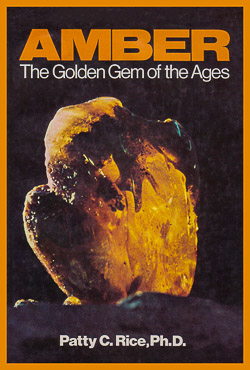
Author:
Patty C. Rice
ISBN-10 : 0442261381
ISBN-13 : 978-0442261382
Amber
The Golden gem of Ages
Amber is referred to as a fossil gem, but this is really a misnomer. Rather than being formed by the substitution of minerals for the original material (as is the case with petrified wood) amber is a polymer, which means that the original tree resins which make up the compound have been transformed into a more stable form. Two properties of amber led me to think that this book might be of interest to the members of the Fallbrook Gem and Mineral Society: the possibility of finding inclusions of ancient insects or other organic matter, which was the basis of the book and movie Jurassic Park; and the fact that some varieties of amber are fluorescent.
In the preface, Dr. Rice states that the purpose of the book is to "educate both the collector and lapidary in all aspects of the science of amber, including its history, its lore, its nature, its modern sources, and its commerce." The length of time amber has been used as a gem, about 4,000 years, guarantees an interesting history. Rice's book covers the historical aspects of amber in mind-boggling detail. Although the history and lore of amber are thoroughly covered, those readers interested in the "science of amber" will be disappointed. For example, I got to the end of the book without ever finding a precise definition of "blue earth," which is the geological layer in which amber is typically found. Beyond feeling that the science is limited, it is my opinion that enough is missing from the book to prevent it from being a worthwhile investment for most amateur collectors. Some instances, where information useful to the collector is omitted, are discussed below.
Although amber is relatively soft, it can be used to make jewelry and can certainly provide interesting specimens. Despite many pictures of exquisite jewelry and specimens, after finishing the book I still had difficulty determining how I should properly choose a specimen or piece of jewelry. There are several properties of amber that influence its value. These include clarity, color, and the number and types of inclusions. The book amply covers all the variations in each of these attributes but makes no attempt to impart much insight as to how to balance one against the other. For example, would a cloudy specimen containing a rare beetle be more desirable than a clear bright specimen with essentially no inclusions? The book provides no help. From a purely academic point of view, such practical matters might not be relevant, but the answers to these questions are among the reasons a collector consults a reference book.
The portion of the book which covers drilling, polishing, and faceting is barely over ten pages. There is very little detail on each of these subjects. What is there appears to be inadequate to guide most amateurs who wish to undertake such a project. Similarly, the information on which varieties of amber are fluorescent is brief and scattered through the book instead of being properly organized.
In addition to the history of amber, there is other material in the book that could possibly justify its purchase. The chapters on identifying imitation amber and resins that resemble amber are quite good. There is a reasonable amount of detail concerning how to test for synthetics and less desirable natural materials that are frequently passed off as amber. This information could be of value to dealers who are interested in marketing high quality amber products or to individuals who wish to purchase amber specimens or jewelry.